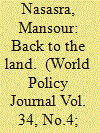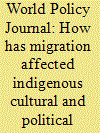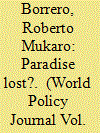|
|
|
Sort Order |
|
|
|
Items / Page
|
|
|
|
|
|
|
| Srl | Item |
| 1 |
ID:
157404


|
|
|
|
|
| Summary/Abstract |
The Indigenous Arab Bedouin have lived in southern Palestine for centuries, mainly in the city of Beersheba, known as Bir al-Saba’ in Arabic. The community preserved its traditional Islamic culture under Ottoman and British rule, and has continued to do so under the sedentarization polices of the Israeli state. Various regimes have come and gone in the Naqab, a region that today accounts for more than half of Israel’s landmass, but the Bedouin have remained loyal to their ancestral lands.
|
|
|
|
|
|
|
|
|
|
|
|
|
|
|
|
| 2 |
ID:
157402


|
|
|
|
|
| Summary/Abstract |
When I was a child growing up in Hammerfest, a small coastal town in the north of Norway, my family would take regular trips to our cabin in the northern hamlet of Skaidi. On the way there, we would always drive past “Stallo,” a huge, pointy rock that my mother would ask my brother and I to greet. This was very important, she told us, if we wanted good luck on our journey. I learned later in life that stallo is the Sámi word for “troll.” Back then, I had no idea that “Stallo” had its origins in the Sámi language, but then again, I didn’t know at that time that I too had Sámi origins.
|
|
|
|
|
|
|
|
|
|
|
|
|
|
|
|
| 3 |
ID:
157399


|
|
|
|
|
| Summary/Abstract |
Picture the American city. You can see it and so can I: gleaming post-industrial buildings, businesspeople in suits, working-class people toiling in service jobs, de-industrialization galore. Now, picture Native Americans. Not as illustrations in history books, but alive on reservations, maybe even leading protests, out of sight but somewhere in the American hinterland. These images don’t fit together very well. For many, they are juxtaposed: The former represents the pinnacle of progress, the latter the periphery and past. Yet according to the Census Bureau seven in 10 Native Americans, or 3.7 million people, live in cities. Even among the budding Indigenous intelligentsia, there is often a disconnect between our everyday realities and the way we place and tell our stories.
|
|
|
|
|
|
|
|
|
|
|
|
|
|
|
|
| 4 |
ID:
157405


|
|
|
|
|
| Summary/Abstract |
With their striking flora and fauna and consistently pleasant temperatures, it’s no wonder that the Caribbean islands are often described as paradise. Across the region, ecosystems ranging from high-elevation cloud forests to cactus scrublands boast an incredible array of plants and animals. The Caribbean is also designated as a biodiversity hotspot, which means that its rich natural resources are under threat of destruction. About 70 percent of its original habitats have been lost to natural processes such as water and wind erosion, as well as human activities like deforestation, chemical dumping, and construction. Rising sea levels are another looming menace.
|
|
|
|
|
|
|
|
|
|
|
|
|
|
|
|
| 5 |
ID:
157400


|
|
|
|
|
| Summary/Abstract |
Bikin National Park is one of very few areas in the Russian Far East that remain untouched by those I consider the “wild barbarians of civilization.” It is home to the largest cat on the planet, the Amur tiger, and the Bikin River basin, nicknamed “the Russian Amazon.” Its forests are known as the lungs of the Northern Hemisphere, just as the Amazon’s jungles are in the Southern Hemisphere. The Bikin is also the native land of the Udege people, and about 600 of us still live there. The history of Bikin National Park is inseparable from the history of my people, and over the decades the land has been a valuable lens through which to observe the workings of Russian national politics. After years of struggle, in 2015 Bikin became the first national park project in which the government took responsibility for protecting indigenous rights.
|
|
|
|
|
|
|
|
|
|
|
|
|
|
|
|
| 6 |
ID:
157403


|
|
|
|
|
| Summary/Abstract |
The Sámi are the Indigenous peoples of Sweden. For thousands of years, we’ve lived in Sápmi, the Sámi traditional land that extends across northern Sweden, Norway, and Finland, and into the Kola Peninsula in Russia. I belong to a čearru, one of 51 reindeer-herding communities in the Swedish part of Sápmi that is geographically and economically organized around reindeer herding. I’m not a reindeer herder, but many of my relatives are. The reindeer is central to Sámi culture as a source of food and clothing, and was once used for transportation. It’s also significant in another way—for hundreds of years, the Swedish government has used reindeer to control our society.
|
|
|
|
|
|
|
|
|
|
|
|
|
|
|
|
| 7 |
ID:
157406


|
|
|
|
|
| Summary/Abstract |
Indigenous peoples regard self-determination as the prerequisite for the exercise and enjoyment of all other human rights. Self-determination is defined as the right of a group to “freely determine [its] political status and freely pursue [its] economic, social, and cultural development.” My personal efforts to enshrine this right in the U.N. Declaration on the Rights of Indigenous Peoples began in 1984. That year, I was a member of a group of seven to eight Indigenous representatives primarily from the Americas who had gathered to produce a document that would reflect Indigenous worldviews. We were sequestered in a small room adjacent to the ongoing plenary session of the World Council of Indigenous Peoples at a prominent hotel in Panama City. The intent was to finalize a declaration for the 1985 session of the U.N. Working Group on Indigenous Populations, which could then be attached.
|
|
|
|
|
|
|
|
|
|
|
|
|
|
|
|
| 8 |
ID:
157401


|
|
|
|
|
| Summary/Abstract |
In 1840, English officials on behalf of the British crown signed the Treaty of Waitangi—also known as Te Tiriti o Waitangi—with the Indigenous Māori population, affirming Māori sovereignty and guaranteeing their collective rights to the country’s land and resources. Since the 1700s, English settlers had been arriving in Aotearoa (the Māori name for New Zealand) to capitalize on the seal and whale trade. As the number of settlers increased, reports flowed back to Britain of general lawlessness and dubious private land deals, and the crown was forced to consider how best to control its citizens. A treaty with the Māori, officials decided, was the way to do so. The agreement, which established the basis for the relationship between the Māori and the British, is commonly cited as a shining example of how a treaty can recognize and protect Indigenous peoples’ rights by..
|
|
|
|
|
|
|
|
|
|
|
|
|
|
|
|
| 9 |
ID:
157407


|
|
|
|
|
| Summary/Abstract |
My name is Roxana Argandoña. I come from the Chapare province in the Cochabamba department of central Bolivia. I have lived in the Chapare most of my life. In the past, its hills and vegetation generated a tropical climate, but logging and deforestation have made it much drier. There also used to be fewer people here, and they were all locals. Over time, people from other parts of Bolivia started colonizing the area. Even the coca has changed: The plants we grew used to be healthier, and there were bigger yields. We would wrap them in blackberry and banana leaves and carry the harvest to local markets on foot. Traders bought coca from us for next to nothing. The market was smaller then, and the money we earned was only enough for us to feed our families. Now, prices are much higher, and..
|
|
|
|
|
|
|
|
|
|
|
|
|
|
|
|
|
|
|
|
|